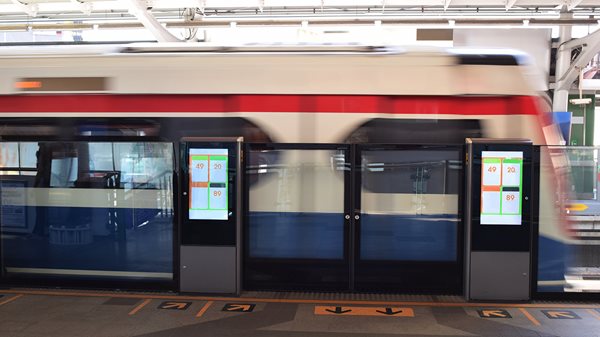Digital signage is a dynamic and growing market, supported by the growth of high-speed networks, improved communications technologies, and the ability of digital signage to engage and inform. The key to success in this industry is in solving the challenges of speed, reliability and security.
Challenges Facing the Digital Signage Industry 
The digital signage industry is more vast and complex than it may seem at first blush. Those who enter the field – whether from the development, deployment, creative or information technology standpoint – quickly learn that digital signage solutions have regulatory requirements and must be highly secure.
Additionally, costs are a key challenge, particularly with installation across decentralized footprints. When it comes to digital signage, calculating the cost of operations and ownership is complex, as it includes hardware, software, connectivity, deployment, management applications, security monitoring and a range of personnel.
Challenges and requirements at a glance:
- Digital signage vendors are responsible for some of the most public-facing messaging we experience on a daily basis, like advertising, travel guidance and important announcements such as Amber alerts and weather alerts. To build a strong reputation, vendors must meet very high standards for reliability as alerts can be critical and advertisers are paying to be seen.
- Security is critical, as data must travel between management applications and end devices, rapidly and securely, without tampering. For example, consider the possibility of security breaches and the potential embarrassing impact on messaging and images on billboards or signage in airports and subways.
- Connectivity methods range in cost and complexity, making their selection one of the greatest challenges. Wired LAN installations can cost hundreds of dollars per month per sign and can be subject to failure if a line is cut. And installation of landlines can take weeks or months. While Wi-Fi networks can be a cost effective solution, the quality of service comes up short. Wi-Fi Internet connections are unreliable, especially in high-traffic locations which are subject to usage overloads that result in timeouts and disconnects.
Selecting the right technology vendor can go a long way toward easing these challenges and ensuring a successful and cost-effective digital signage deployment strategy.
Digital Signage Technology

Like vehicle technologies, which must support everything from passenger vans to race cars to commercial delivery fleets, the technology behind digital signage must support an enormous range of use cases. The needs of an indoor shopping mall or airport signage deployment, for example, differ significantly from the requirements of outdoor signage that faces temperature and humidity swings.
Digital signage technology considerations at a glance:
- Hardware specifications: Signage solutions for roadside construction, outdoor spaces in cities and transit deployments must be ruggedized to withstand environmental factors such as vibration and extreme weather conditions. In indoor environments, they must have the ability to provide a quality signal even in dense buildings with obstructions like walls and pillars.
- Connectivity: The technology for connecting digital signage and supporting communications systems is vast today, ranging from many types of installed infrastructure to cellular, and several combinations thereof. For example, wired lines can provide a primary connection with failover to wired or to cellular. But increasingly, cellular is the choice for primary connections, due to the challenges we outlined above, as well as the improvements in cellular networks and declining carrier costs.
- Power requirements: Digital signage for some applications can have a significant power draw. For example, electric utilities need to monitor power using current transformer meters, which may need to be supported by additional connectivity.
- Security: Devices such as routers that support digital signage must be "secure by design," as we say at Digi. This means the devices need to have built-in security and be thoroughly tested. Security must be established at multiple levels, from secure boot to encryption and authentication of passwords and data. Further, it is critical for the hardware technology to be integrated with a management solution that supports mass firmware updates to act quickly when the industry identifies cybersecurity threats.
Why Cellular Routers Are the Growing Connectivity Trend
Today, cellular routers are replacing gateways, wired infrastructure and legacy systems as the critical connectivity for digital signage. Let's look at the key reasons driving this change:
- Reason #1: Cellular routers are easy to install and, since they’re compact, can be positioned almost anywhere for optimal reception. Most routers install in less than an hour.
- Reason #2: Cellular routers with multi-carrier support enable signage operators to remotely switch cellular carriers for optimal signal strength to minimize downtime.
- Reason #3: Cellular solutions can be managed remotely by an IT team. Remote monitoring and optimization of the router-to-tower cell connection can help ensure maximum uptime. IT can also reboot digital signs and remotely diagnose issues with sign infrastructure. This can dramatically minimize the need to send personnel out to troubleshoot, diagnose and fix problems.
- Reason #4: Remote access via cellular also means you can update digital signage content immediately and at low cost. And there is no longer a need to send USB drives by surface mail, with all the costs and security concerns surrounding that method of content deployment. Everything is updated simultaneously, securely and quickly.
- Reason #5: Cellular can replace multiple technologies that are slower, less reliable, and are more expensive to install and maintain. Today, industrial and enterprise cellular routers leverage network speeds, security and reliability that were never previously available. These highly sophisticated devices have stateful firewall capabilities to reconcile incoming data with outgoing requests and protect themselves against cyberattacks using the same sophisticated methods as a corporate data center.
Digital Signage in the New 5G Era

Another key reason cellular is becoming ubiquitous is because of high quality LTE connections and evolution of 5G.
The full deployment of 5G will eventually revolutionize the communications landscape. Today, we are still in the early stages, and the cost of early adoption is extremely high. At Digi we are keeping our fingers on the pulse of development, and have a
product roadmap to support our customers'
5G journey, and we believe this is the time to strategize for the future while optimizing deployments using the available high-performance LTE technology.
Let's look at 5G today and what we can expect as these networks mature.
5G connectivity is only available in dense urban areas today, and for the foreseable future. This is because of cell density and the time and cost to fully deploy beyond urban areas.
For digital signage applications, it's important to note that the bandwidth and latency gains from 5G aren’t necessarily beneficial. Additionally, 5G is currently only being delivered at the highest possible speeds, so lower-bandwidth applications don’t make much economic sense. Some exceptions could be scenarios involving large, high-resolution, streaming video content that must be updated frequently.
Fortunately, 4G LTE technology is perfectly adequate to support most applications today, and will be available long term, as we have discussed in previous blog posts, such as
2G, 3G, 4G LTE Network Shutdown Updates and
4G to 5G: How Long Will 4G LTE Be Available? As cellular technologies typically have a lifecycle of about 20 years, we can reasonably expect 4G LTE to be available and effective for another decade.
As such, most signage operators will want to rely on LTE until 5G is more broadly deployed and economy of scale becomes possible. At the same time, there is strong adoption of other
complementary technologies like AI and machine vision that allow media companies to identify the demographics of a specific viewer, tailor content accordingly, and generate more meaningful impressions.
Edge compute capabilities are also providing the ability to deliver highly relevant, localized content in real-time based on the location, weather, and audience.
Digital Signage and Security

We have touched on the critical nature of security for digital signage, and it must be underscored. Cyber attacks are one of the biggest risks for digital signage, involving outside entities seizing control of a billboard or sign.
These hacks can involve stealing digital assets or displaying unauthorized text and images. But there is much more at stake than the possibility of inappropriate content on a public sign. Distributed denial of service (DDOS) attacks can shut down an entire signage network. In other cases, hackers steal bandwidth, leaving you with inflated data-usage bills.
Losing control of digital assets can result in a range of business impacts, from contract issues and SLA violations, to billing disputes, lawsuits, reputational damage, and more. This is why it is critical for digital sign companies to make security a primary element of the field communications infrastructure.
Security vulnerabilities can be caused by a range of issues, including non-secure product design, and a lack of stringent protocols and best practices. For example, it can be as simple as using the same password across a fleet of devices. Or the devices may have out-of-date software or could be missing security patches.
Cellular technology can provide significant advantages in digital signage security. Here are the steps you can take to bolster security with a cellular deployment:
- Ensure that the cellular routers you deploy to the field offer a comprehensive enterprise-class security feature set. For example, Digi cellular routers integrate Digi TrustFence®, a security framework with extensive security features such as:
- Secure boot, which validates that firmware on the device is approved by the manufacturer
- Protected hardware ports to prevent unwanted local (on-site) intrusions
- Data authentication and device-identity management to validate users and data transfers
- Encryption protocols for data and over-the-air (OTA) transmission to ensure the integrity of data flowing across the network
- Work with a manufacturer that does not use default user and password settings; today manufacturers must employ unique passwords for optimal security.
- Utilize a centralized security and management platform, like Digi Remote Manager®, which acts as a watchdog over potential tampering of defined configurations. Here are a few key features:
- This platform actively monitors device configurations to detect if changes have been made (intentionally or unintentionally) and then resets them back to the prescribed configuration and sends alerts to the appropriate IT resources.
- Digi Remote Manager enables you to schedule mass firmware updates and security patches to groups of devices with just a few clicks - whether you have dozens or thousands of deployed devices.
- Additionally, it can monitor cellular device performance and uptime data to help ensure connection reliability and appropriate data consumption.
A combination of these strategies can provide cost-effective security and reliability for digital signage on cellular networks.
For answers to burning questions or to start a conversation on digital signage solutions,
contact us.